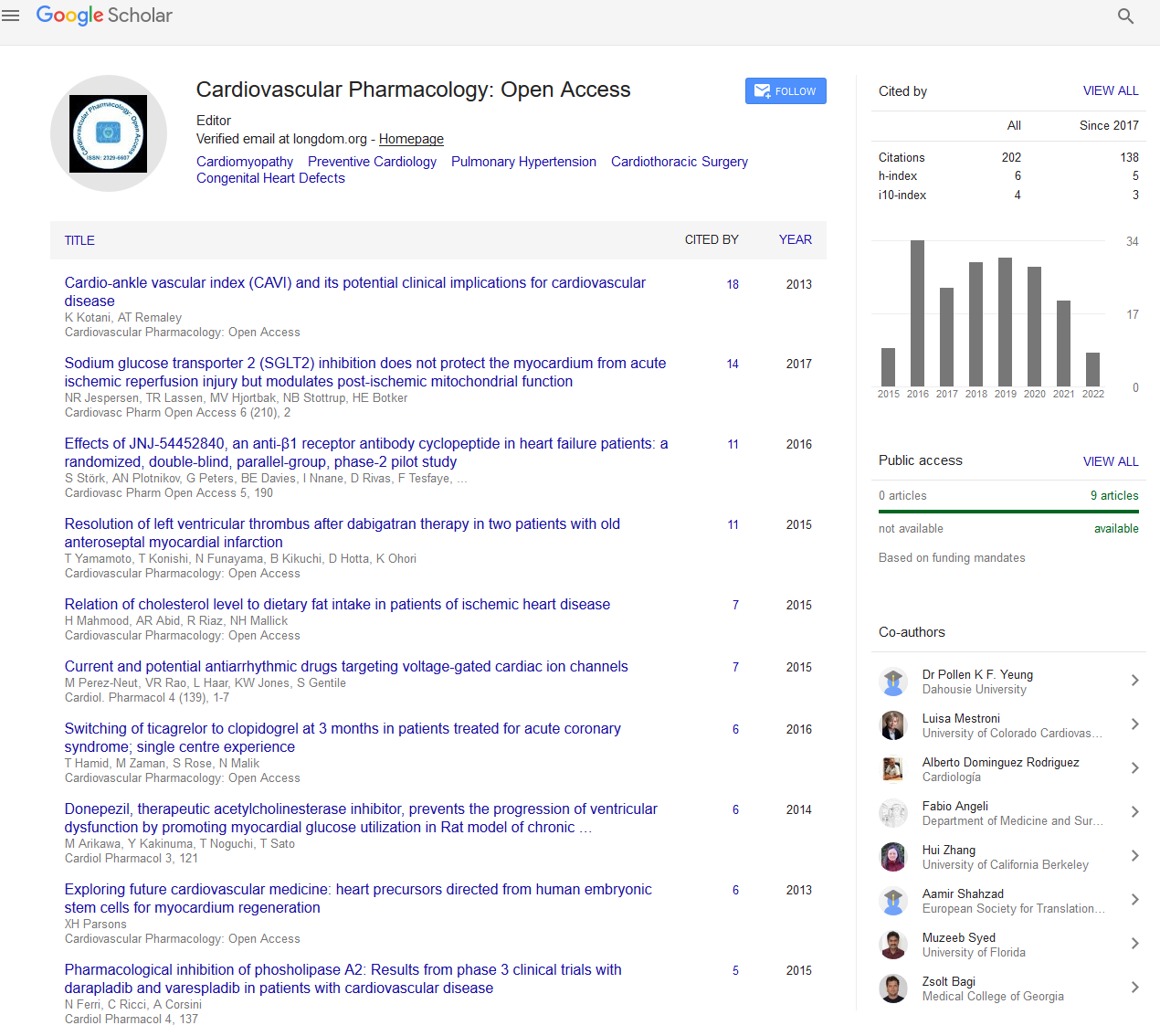Indexed In
- Open J Gate
- Cosmos IF
- RefSeek
- Hamdard University
- EBSCO A-Z
- OCLC- WorldCat
- Publons
- Geneva Foundation for Medical Education and Research
- Euro Pub
- Google Scholar
Useful Links
Share This Page
Journal Flyer

Open Access Journals
- Agri and Aquaculture
- Biochemistry
- Bioinformatics & Systems Biology
- Business & Management
- Chemistry
- Clinical Sciences
- Engineering
- Food & Nutrition
- General Science
- Genetics & Molecular Biology
- Immunology & Microbiology
- Medical Sciences
- Neuroscience & Psychology
- Nursing & Health Care
- Pharmaceutical Sciences
Commentary - (2023) Volume 12, Issue 2
Hypertension as a Significant Risk Factor in Coronary Heart Diseases (CHDs)
Morris Dom*Received: 02-Mar-2023, Manuscript No. CPO-23-20549; Editor assigned: 06-Mar-2023, Pre QC No. CPO-23-20549 (PQ); Reviewed: 20-Mar-2023, QC No. CPO-23-20549; Revised: 27-Mar-2023, Manuscript No. CPO-23-20549 (R); Published: 03-Apr-2023, DOI: 10.35248/2329-6607.23.12.340
Description
The major impact of hypertension is Coronary Heart Disease (CHD). A sustained increase in Blood Pressure (BP) can unstable vascular lesions and trigger acute coronary events. Hypertension speeds up the development of atherosclerosis. Even without CHD, hypertension can result in myocardial ischemia. By maintaining ideal blood pressure control, these cardiovascular risks linked to hypertension can be diminished. Although there are many antihypertensive medications available, it is still debatable which medication and target blood pressure should be used for patients with CHD.
Heart Failure (HF) and stroke are two conditions for which hypertension is a significant risk factor, but coronary heart disease is of greater importance (CHD). A continuous rise in blood pressure can destabilize vascular lesions and trigger acute coronary events. Hypertension hastens the onset and progression of atherosclerosis.
High blood pressure's physical effects can harm endothelial tissue. Nitric oxide, a powerful vasodilator, is produced and released less effectively by damaged endothelium. This, together with the accumulation of reactive oxygen species and other inflammatory agents, is what causes atherosclerosis, thrombosis, and vascular occlusion. This inflammatory mechanism plays a key role in the pathophysiology of atherosclerosis and hypertension. The sympathetic nervous system and the Renin-Angiotensin- Aldosterone System (RAAS), two systems that support hypertension, also support atherosclerosis. Angiotensin II causes arterial remodeling and vasoconstriction, which raise blood pressure and speed the development of atherosclerosis. This result gives way to the hypothesis that some antihypertensive drugs, such as ACE inhibitors, may also have positive effects on atherosclerosis and CHD in addition to decreasing blood pressure. In the absence of CHD, hypertension on its own can result in myocardial ischemia. Significant left ventricular hypertrophy (LVH), which may limit ventricular relaxation and compromise coronary blood flow during diastole, can be brought on by increased afterload brought on by hypertension. However, the AHA guidelines clarified this matter and advised caution when lowering the DBP below 60 mmHg, which may impair coronary perfusion, while maintaining the same target BP of 130/80 mm Hg as for other high-risk populations. Lowering BP, reducing ischemia, and preventing cardiovascular events and death are the objectives of treating hypertension in individuals with CHD. In order to treat hypertension, no pharmacological therapies should be promoted in all patients. By a number of processes, including a reduction in arterial stiffness, exercise enhances heart function, lowers blood pressure and cardiac afterload. Exercise improves coronary artery flow reserves in CHD patients, although the exact mechanism is unknown. Physical activity has also been related to pathophysiological pathways that may play a role in the development of CHD. Thus, regular exercise is advised for everyone who has hypertension or CHD.
Pharmaceutical treatment is necessary in high-risk individuals such as those with CHD, although lifestyle changes alone may suffice in the general population with prehypertension. For people with CHD or CHD equivalents such as diabetes mellitus, chronic renal illness, peripheral arterial disease, carotid artery disease, and abdominal aortic aneurysm, the recommended goal blood pressure is 130/80 mm Hg.
Unless there are contraindications, -blockers should be used as the first line of treatment for patients with CHD who have hypertension. Hypotension, severe bronchospastic lung disease, decompensated heart failure, sinus or atrioventricular node dysfunction, and severe peripheral vascular disease are some of the conditions that should be avoided when using them. Also, due to the possibility of masking hypoglycemia symptoms, diabetic individuals with a strong history of hypoglycemic episodes should utilize -blockers with extreme care. If blood pressure is high or angina persists while taking beta-blocker therapy, long-acting dihydropyridine Calcium Channel Blockers (CCBs), amlodipine, and nifedipine might be added to the standard treatment plan. When there are contraindications or side effects start to appear, -blockers can also be substituted with the nondihydropyridine medications diltiazem and verapamil.
Nondihydropyridine CCBs can be used as antianginals in conjunction however there is a risk of severe bradycardia or atrioventricular block with these medications. Hence, a longacting dihydropyridine CCB should be used if a CCB is required in addition to a -blocker to treat angina or blood pressure. By producing vasodilation, lowering peripheral resistance, and reducing wall tension, these drugs lower blood pressure by lowering the demand for oxygen in the heart muscle. By expanding coronary arteries, they also boost the delivery of oxygen to the myocardium.
Citation: Dom M (2023) Hypertension as a Significant Risk Factor in Coronary Heart Diseases (CHDs). Cardiovasc Pharm. 12:340.
Copyright: © 2023 Dom M. This is an open access article distributed under the terms of the Creative Commons Attribution License, which permits unrestricted use, distribution, and reproduction in any medium, provided the original author and source are credited.


